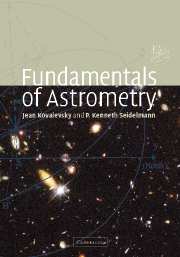Book contents
- Frontmatter
- Contents
- Preface
- List of abbreviations
- 1 Introduction
- 2 New observational techniques
- 3 Basic principles and coordinate systems
- 4 Treatment of astronomical data
- 5 Principles of relativity
- 6 Apparent displacements of celestial objects
- 7 Extragalactic reference frame
- 8 Dynamical reference frame
- 9 Terrestrial coordinate systems
- 10 Earth orientation
- 11 Stars
- 12 Double and multiple star systems
- 13 Astronomical phenomena
- 14 Applications to observations
- Appendix A Examples
- Appendix B Astronomical values
- Glossary
- References
- Index
6 - Apparent displacements of celestial objects
Published online by Cambridge University Press: 05 November 2011
- Frontmatter
- Contents
- Preface
- List of abbreviations
- 1 Introduction
- 2 New observational techniques
- 3 Basic principles and coordinate systems
- 4 Treatment of astronomical data
- 5 Principles of relativity
- 6 Apparent displacements of celestial objects
- 7 Extragalactic reference frame
- 8 Dynamical reference frame
- 9 Terrestrial coordinate systems
- 10 Earth orientation
- 11 Stars
- 12 Double and multiple star systems
- 13 Astronomical phenomena
- 14 Applications to observations
- Appendix A Examples
- Appendix B Astronomical values
- Glossary
- References
- Index
Summary
The apparent direction in the sky at which a celestial object appears is not the actual direction from which the light was emitted. What is observed is the tangent direction of the light when it reaches the observer. For reasons that will be discussed in this chapter, the light path is not rectilinear and several corrections describing the effects of bending, or shifts in direction, are to be applied to the direction from which the light is observed to determine the actual direction of the emission. We shall not deal here with the various transformations undergone by the light within the observing instrument; they are particular to each case. Some examples are given in Chapter 14. We shall consider only the direction from which the light came when it entered into the instrument. One has to consider the atmospheric refraction, the shift in direction due to the combination of the speed of light with the motion of the observer, called aberration, and the bending of light in the presence of gravitational fields. The latter has been already presented in Section 5.4.2, but will be revisited in Section 6.4. Similarly, the geodesic precession and nutation are to be considered when relating the positions from a moving reference frame of fixed orientation to a fixed reference frame of the same orientation (see Section 7.5).
- Type
- Chapter
- Information
- Fundamentals of Astrometry , pp. 121 - 156Publisher: Cambridge University PressPrint publication year: 2004

